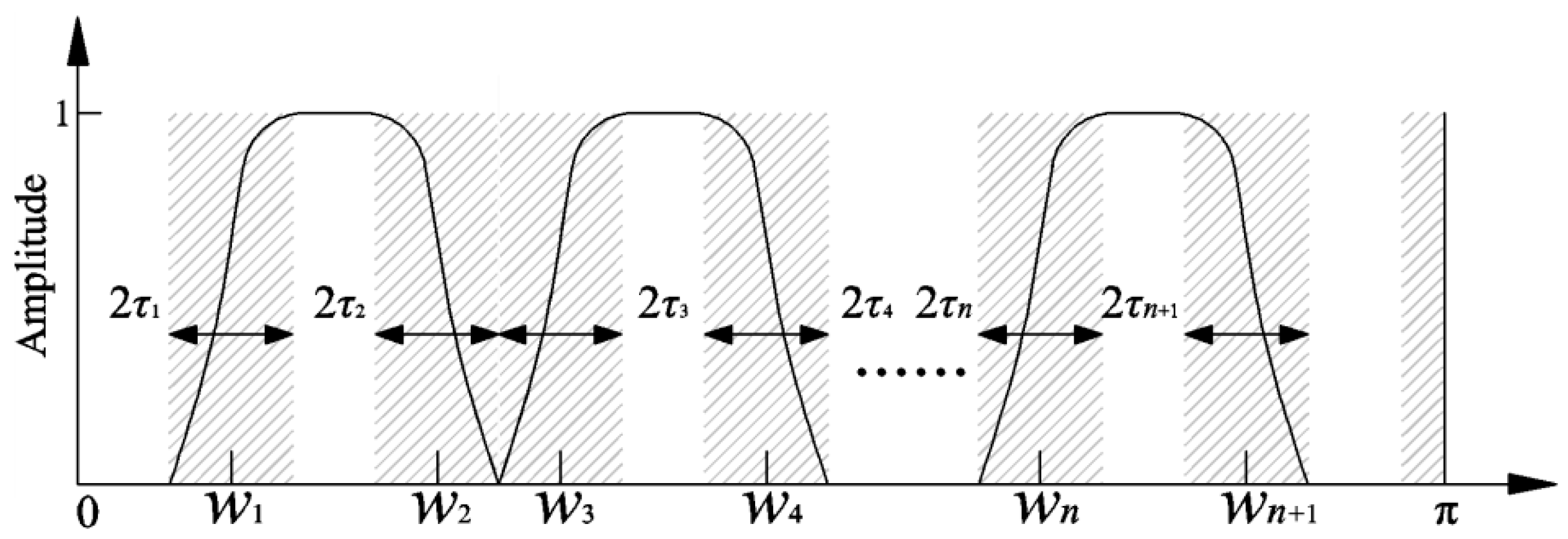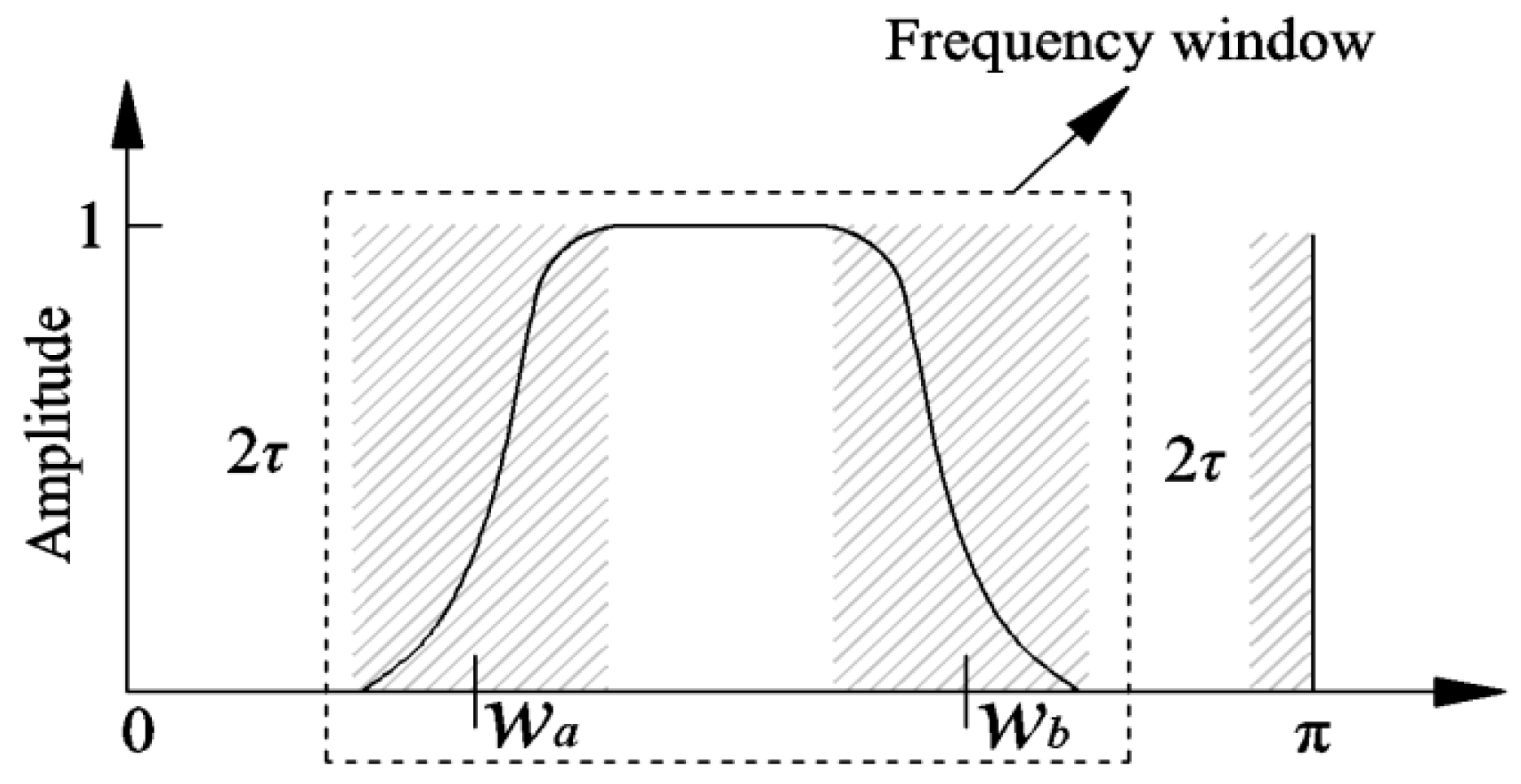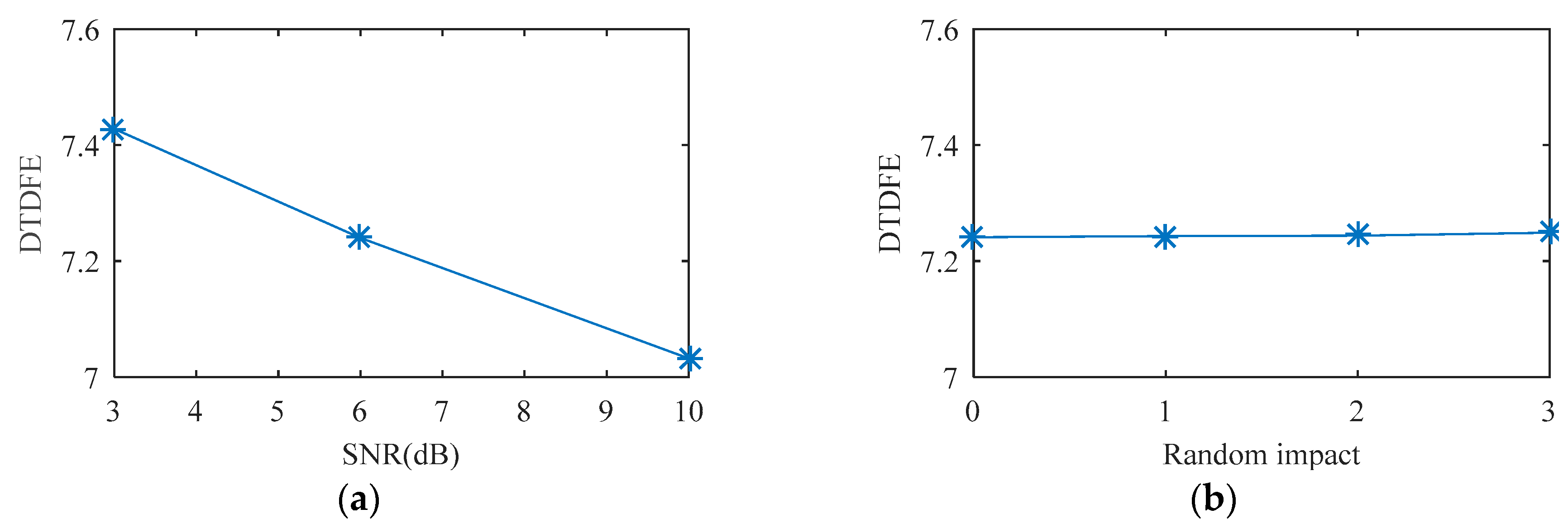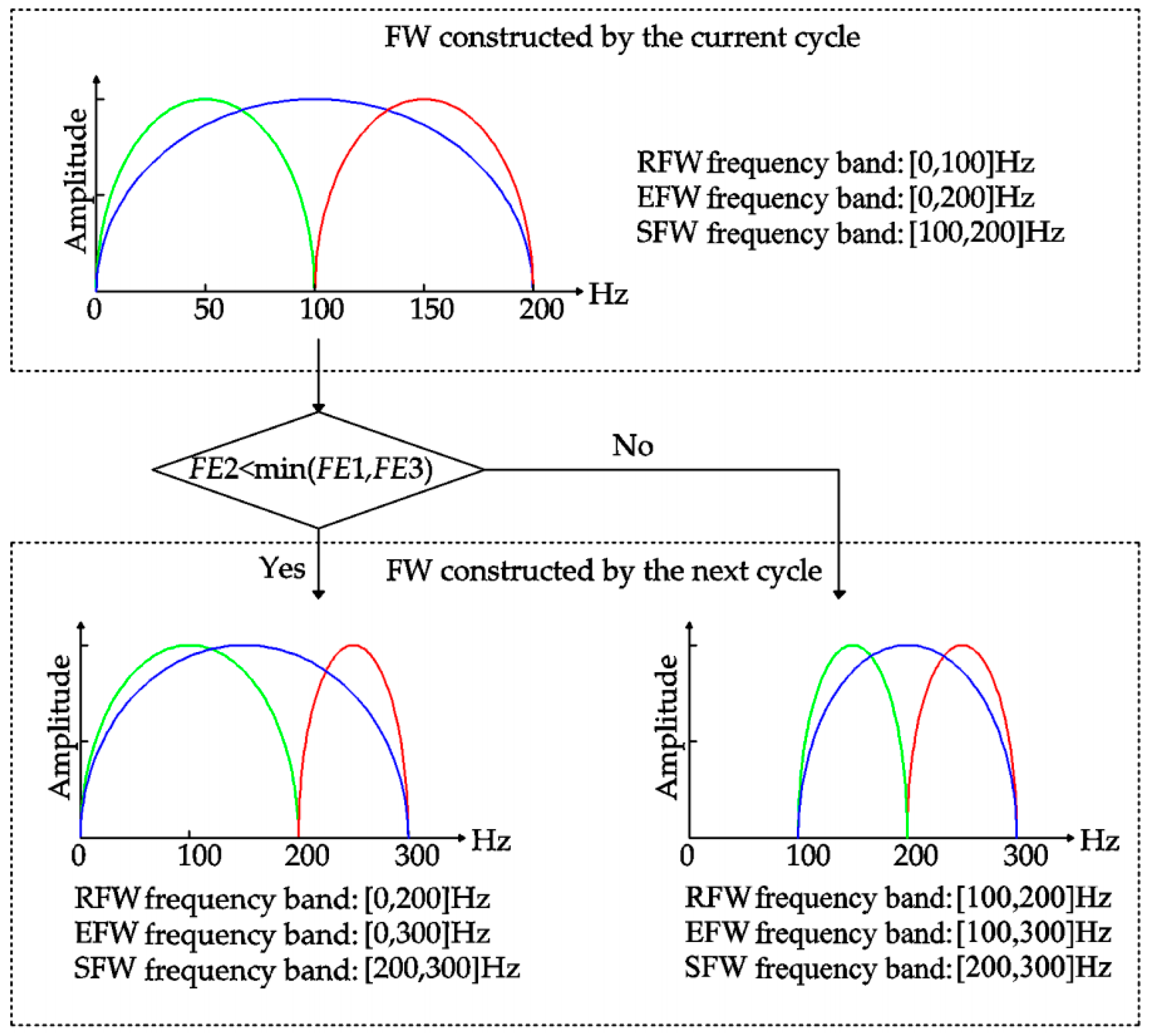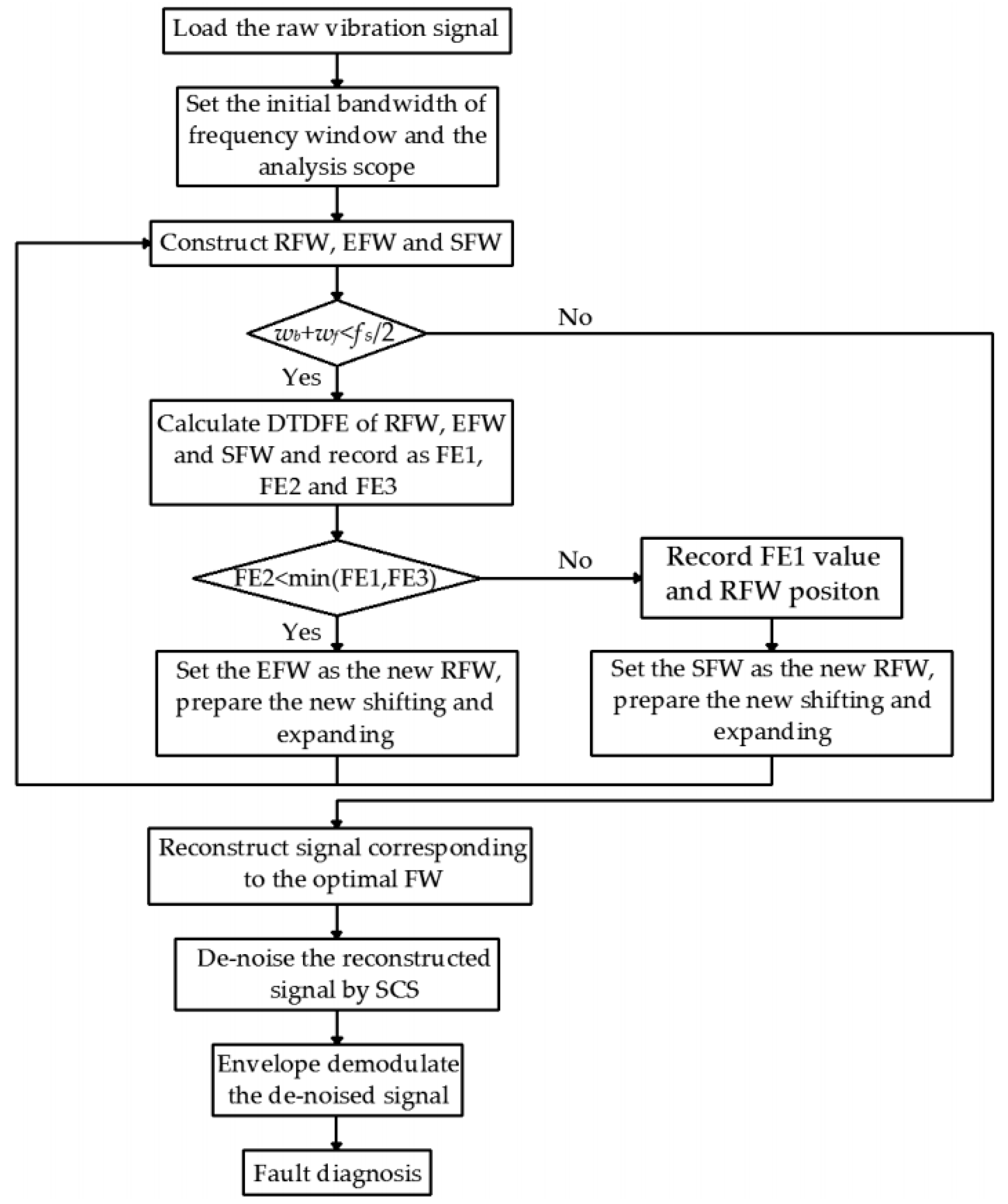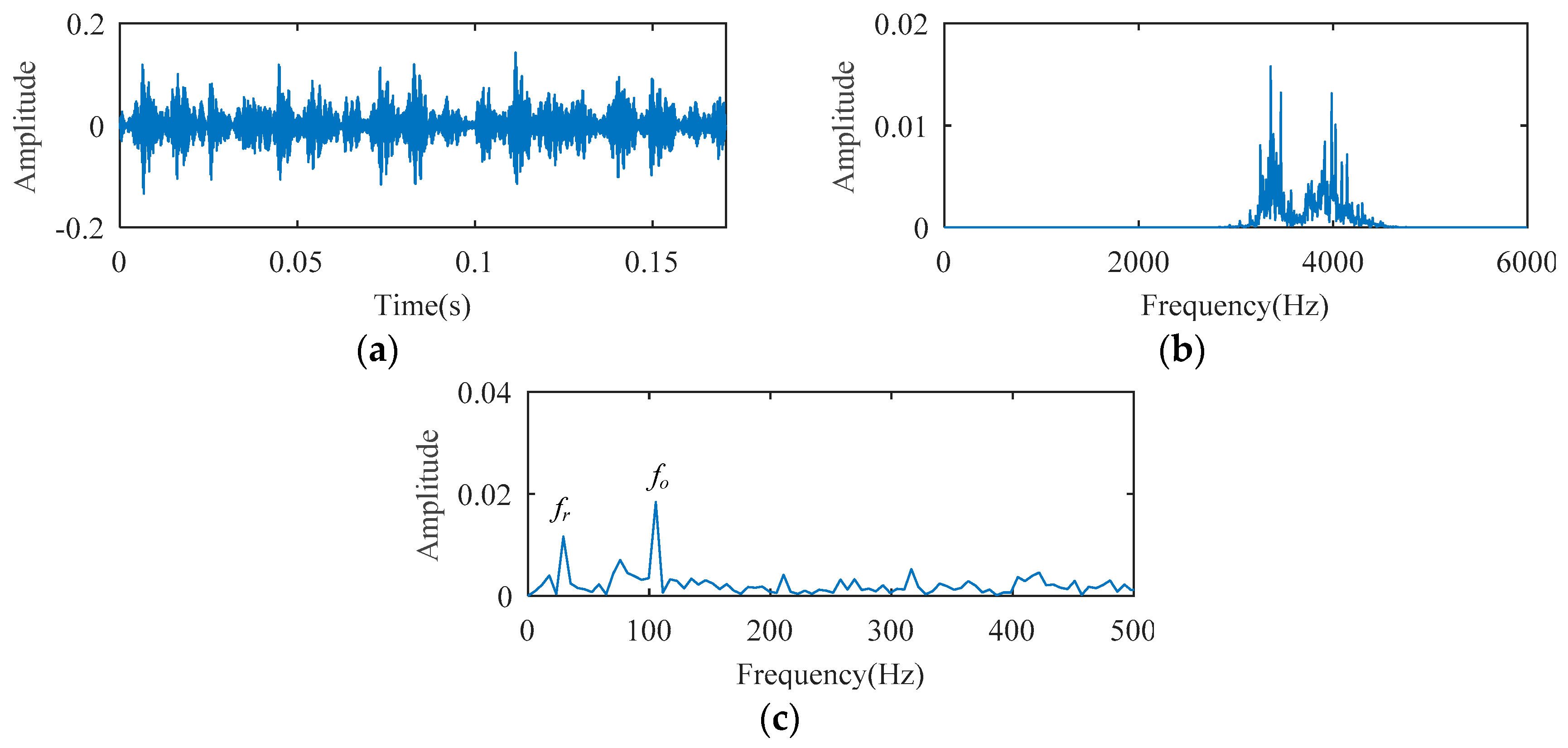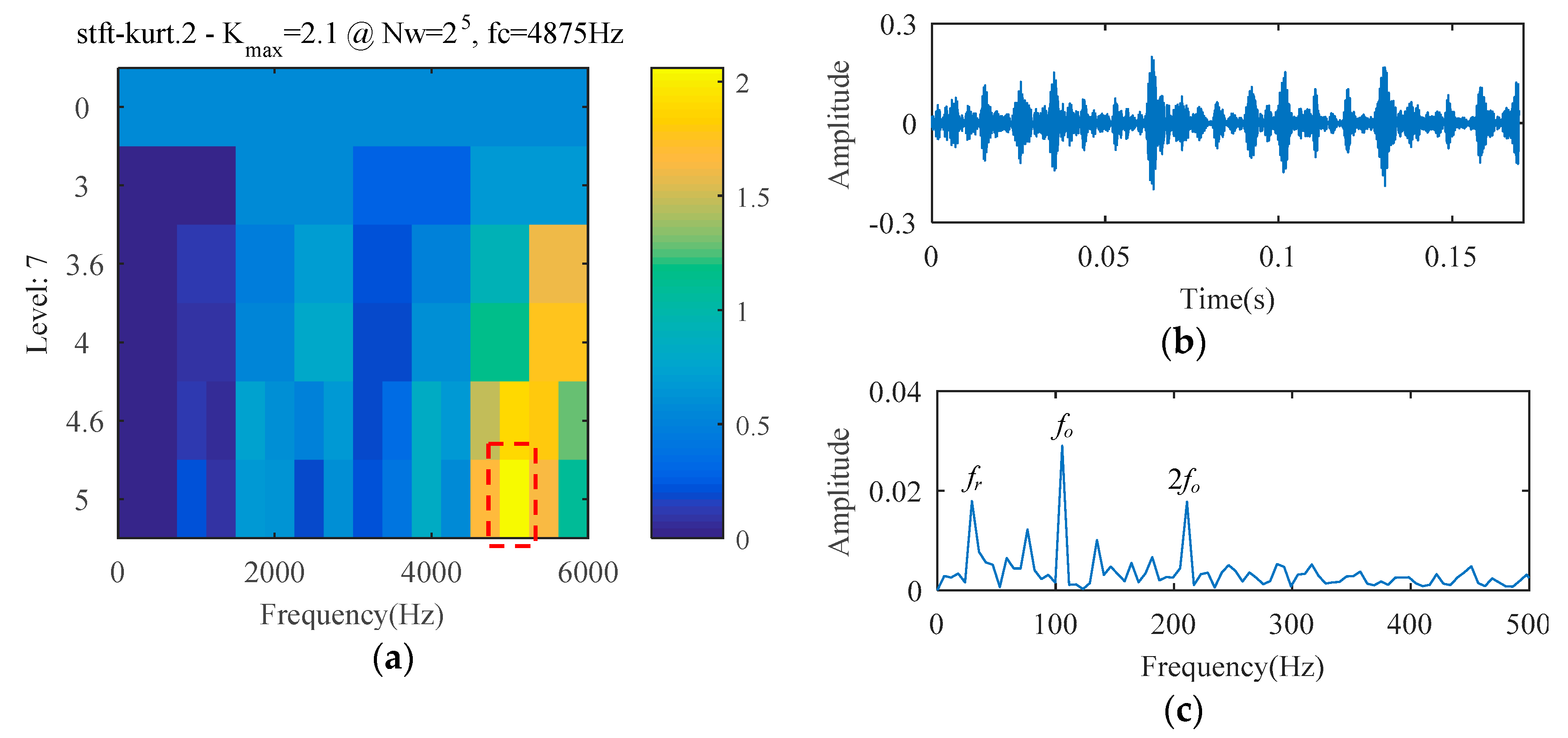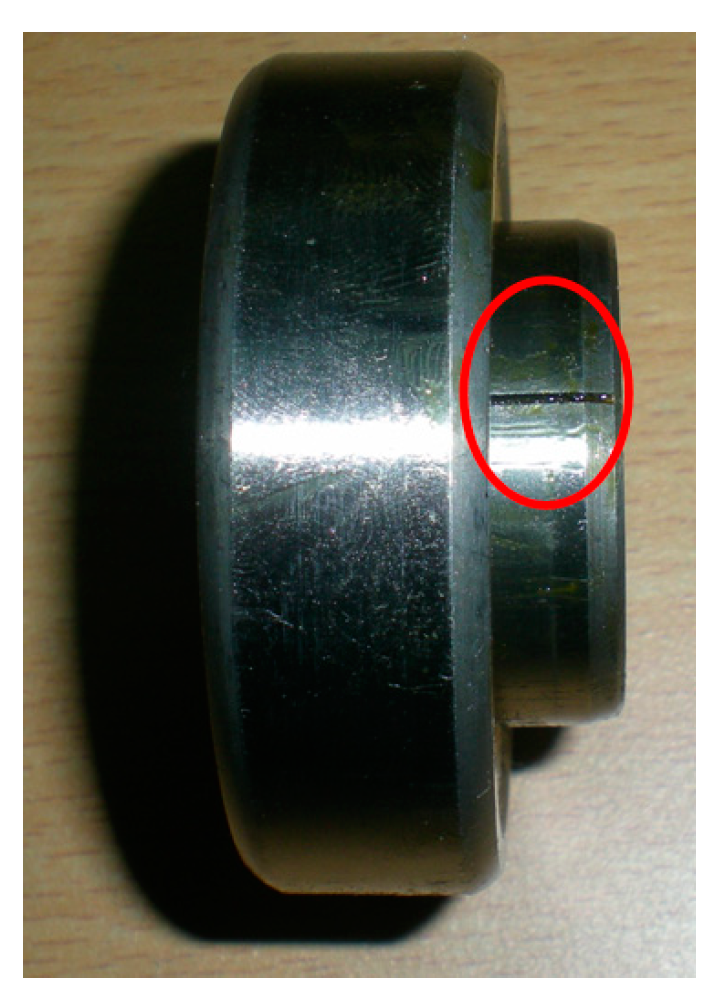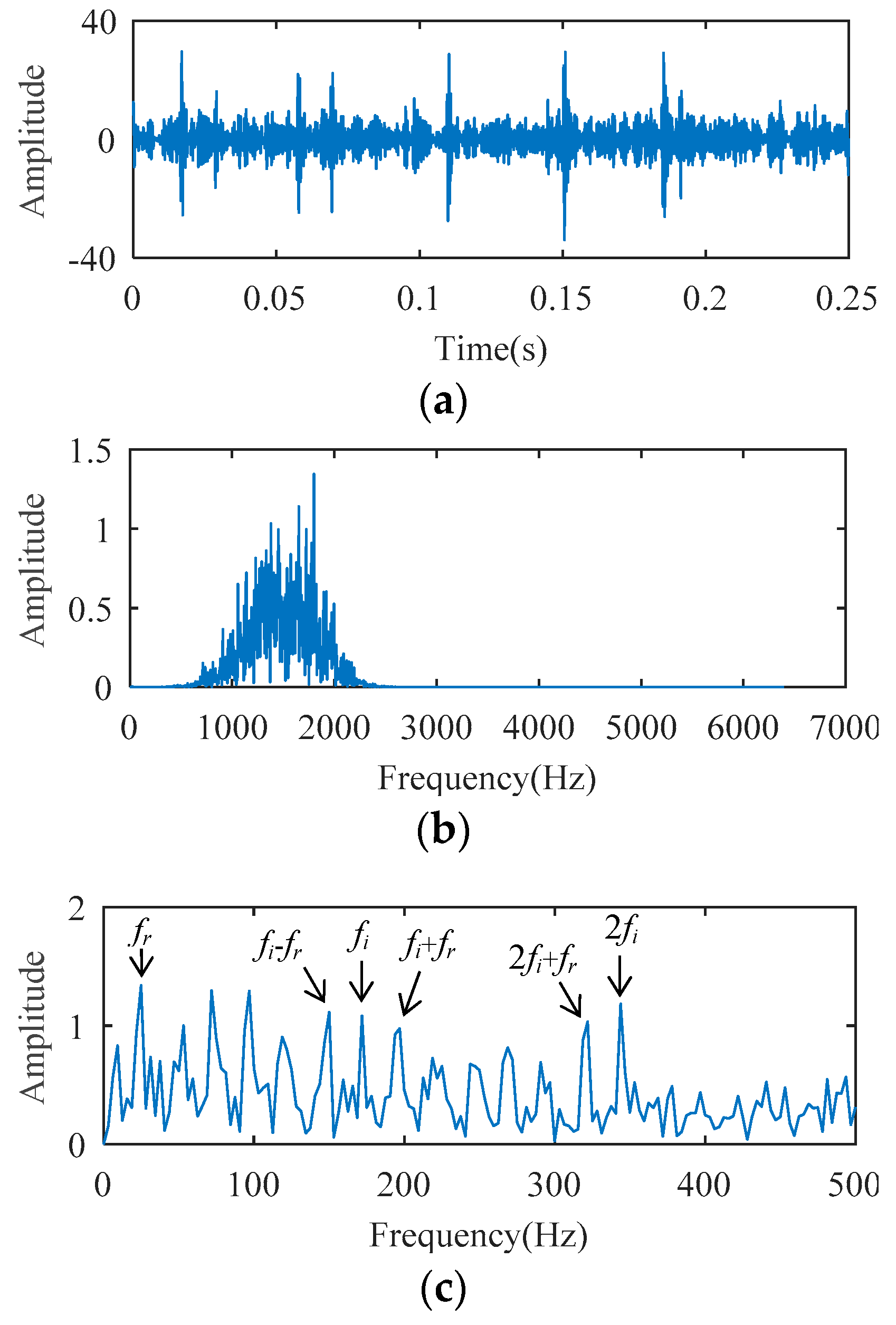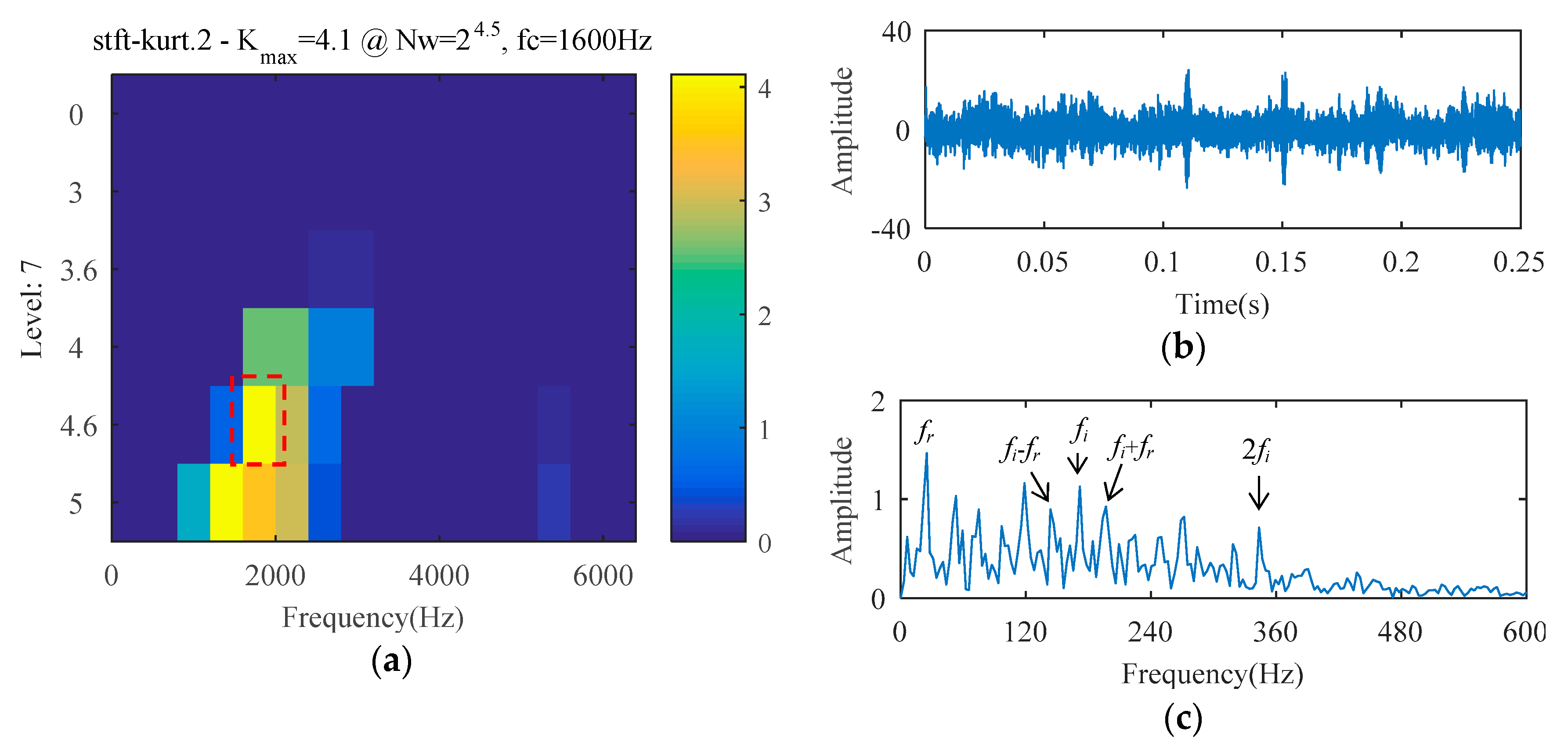1. Introduction
Rolling bearings, a mechanical component with compact structure and effective reduction of friction loss, are widely used in transportation, the energy and chemical industry, lifting machinery, and other fields. Rolling bearing failure will cause equipment shutdown, machine damage, and even serious personal injury. The fault monitoring and diagnosis of bearings is a useful way to decrease the loss of maintenance and ensure the safety of equipment operation [
1,
2].
In the initial stage of bearing failure, the defective size of the contact interface is small, the periodic impact force produced by the component interaction is weak, and the feature information is not obvious. Smith et al. [
3] discussed the performance of envelope analysis, cepstrum prewhitening, and the benchmark method in extracting failure information from early bearing fault signals. In addition, vibration transmission attenuation, strong background noise, and the interference of multiple vibration sources increase the difficulty of feature extraction [
4,
5,
6]. Aiming at this problem, Miao et al. [
7] improved the variational mode decomposition method so that its parameters can be determined adaptively, Jiao et al. [
8] proposed the hierarchical discriminating sparse coding method, while Hou et al. [
9] put forward an integrated method on the basis of globally optimized sparse coding and approximate SVD. Zheng et al. [
10] proposed an NLM-KSVD method for early fault diagnosis of rolling bearings based on shift-invariant K-singular value decomposition (K-SVD) with nonlocal means (NLM) sensitive atom enhancement. Although the above methods can extract weak faults of rolling bearings, complex prior knowledge is needed.
The periodic impact force produced by rolling bearing defects is very weak in the time domain, while the energy distribution is very wide in the frequency domain, arousing the high-frequency resonance of single or multiple mechanical structures such as bearing elements, bearing blocks, etc. The frequency band of resonance response contains abundant fault information, and the fault characteristics can be obtained by envelope demodulation analysis of its corresponding signal. Using resonance demodulation to extract impact response characteristics from the vibration signal is a fast and simple approach for rolling bearing fault diagnosis, the pivotal step of which is to precisely identify the resonance frequency band that contains plentiful fault information. The traditional resonance demodulation approach has three disadvantages. The first one is that the evaluation index cannot distinguish the random impact and periodic impact of the signal, which easily leads to identifying the erroneous resonance band. The second one is that the optimal frequency band may not include the whole resonant frequency band region. The third one is that the parameters of the bandpass filter need to be preset manually. Aiming at these problems, spectral kurtosis was put forward by Dyer [
11] originally, then systematically defined by Antoni et al. [
12,
13,
14], and successfully applied to the determination of the resonance frequency band of rolling bearings. In Reference [
14], Fast Kurtogram (FK), a fast algorithm based on a finite impulse response filter and short-time Fourier transform, was used to adaptively identify the optimal resonance frequency band. However, the FK algorithm has two obvious shortcomings; one is that the frequency band is decomposed by dichotomy/trichotomy, causing the over-decomposition of the determined resonance band. The other is that the kurtosis index is susceptible to random noise and accidental shock; as a result, the determined frequency band is not the resonance frequency band aroused by the bearing defect. In order to improve the FK algorithm, Lei et al. [
15], Gu et al. [
16], and Wan et al. [
17] proposed improved methods using wavelet packet to construct the filter that better matches the fault impact. Although such improvements can improve the identification accuracy, the resonance frequency band is easily segmented by the adjacent subset because of the pyramid frequency segmentation method. Su et al. [
18], Chen et al. [
19], and Wan et al. [
20] utilized the genetic algorithm, particle swarm optimization algorithm, and water cycle algorithm to determine the function of the Morlet wavelet and asymmetric real Laplace wavelet, and constructed the bandpass filter with an arbitrary Q quality factor to realize adaptive matching of the resonance frequency band. However, such improvements require a lot of prior knowledge, as the optimization algorithms are relatively complex. Wang et al. [
21] put forward an adaptive spectral kurtosis method using the maximum spectral kurtosis, continuously expanding the window function in the overall frequency range to determine the optimal resonance frequency band. This improvement can effectively preserve the whole resonance frequency band without the complex optimization process. In addition to the improvement of filter design, many scholars also discussed the evaluation criteria of bandpass filter signal. Yu et al. [
22] and Obuchowski et al. [
23] described the bearing fault response more accurately by introducing some new statistical models, such as alpha-stable, Jarque–Bera, Kolmogorov–Smirnov, etc. Considering the periodicity of fault impact, Zhang et al. [
24] used correlation kurtosis instead of kurtosis to identify the resonance frequency band in diagnosis. Wang et al. [
25,
26] concluded that the envelope spectrum of the demodulated signal corresponding to the resonance frequency band is sparse, and proposed the Sparsogram method that calculates the kurtosis of the envelope spectrum. Antoni et al. [
27] utilized the spectral negentropy of the time domain to represent the impact characteristic, and the spectral negentropy of the frequency domain to represent the cyclostationality characteristic. A method named Infogram based on average spectral negentropy was proposed.
Although most of the background noise in the signal can be filtered by extracting the resonance band caused by bearing fault through a bandpass filter, the noise in the filter passband cannot be filtered out. Especially in the analysis of strong noise signal, the effective removal of noise in the signal can highlight the relevant feature information and increase the failure identification accuracy. Sparse code shrinkage (SCS) was put forward on the basis of maximum-likelihood estimation theory [
28]. This method was successfully applied not only to sparse analysis and image de-noising, but also to fault signal diagnosis of mechanical equipment. Lin et al. [
29] utilized the maximum-likelihood estimation function of SCS as the soft threshold function of wavelet threshold de-noising for diagnosis pf gear faults, but the diagnosis effort was not ideal under the strong noise interference due to a lack of pre-filtering. Wang et al. [
30] put forward an integrated method based on wavelet packet and SCS, which can filter the noise contained in the crack signal, but which needs manual selection of the wavelet packet coefficients to reconstruct the signal for subsequent SCS processing. Yu et al. [
31] combined intrinsic time-scale decomposition (ITD) and SCS to diagnose the bearing failure type. However, the baseline of ITD is obtained by the linear transformation of the signal itself, making the waveform of the decomposed proper rotation components appear blurred and distorted, then leading to the inaccurate decomposition of a multi-component AM/FM signal.
Inspired by the above references, a fault diagnosis method on the basis of adaptive frequency window and sparse code shrinkage (i.e., AFW-SCS) is put forward to address the fact that the feature information of rolling bearing early faults is easily submerged by background noise. The AFW can slip along the whole frequency axis and extract the frequency band arbitrarily. Dual-time domain feature entropy is proposed to evaluate the strength of periodic components of the reconstructed signal corresponding to the AFW. According to this evaluation index, the optimal frequency window position is determined adaptively by shifting and expanding the window bandwidth, and covering the resonance band caused by the bearing fault. The reconstructed signal corresponding to the optimal frequency window is further de-noised by the SCS algorithm to make the impact characteristic more prominent and the diagnosis result more accurate. Two experimental signals and the data files of Case Western Reserve University for different operation conditions are applied to validate the effectiveness and the universality of AFW-SCS approach.
The paper consists of five sections.
Section 2 illustrates the concept of the frequency window and its adaptive optimization process.
Section 3 reviews the theoretical knowledge of SCS.
Section 4 exhibits the implementation procedure of the AFW-SCS method.
Section 5 validates the feasibility and superiority of the AFW-SCS method through two experimental signals and some existing analysis methods.
Section 6 draws some conclusions.
2. Adaptive Frequency Window
According to the idea of Reference [
32], the adaptive frequency window is proposed to overcome the shortcomings of spectral boundary division caused by frequency domain extreme points. In the next section, the concept of frequency window is firstly introduced. Then, the dual-time domain feature entropy is proposed and used as the evaluation index of the frequency window. Finally, the optimization process of the adaptive frequency window is introduced.
2.1. Concept of Frequency Window
Empirical wavelet transform (EWT) can extract the single AM/FM component with a compact spectrum by dividing the Fourier spectrum of the signal and performing orthogonal empirical wavelet transform. Assuming that the signal
x(
t) is composed of
N single AM/FM components, the spectrum range is normalized to [0, π]. In order to extract all single components, it is necessary to divide [0, π] into
N continuous intervals, and the divided spectrum is as shown in
Figure 1. The
N continuous intervals of the spectrum are expressed as Λ
n = [
wn−1,
wn] (
n = 1, 2, ...,
N). The shadow part with the center of
wn and the width of 2
τn is the transitional region of each segmentation interval, and satisfies the following requirement:
The distribution of extreme points in the signal frequency domain X(f) directly determines the process of signal spectrum segmentation. The extreme points caused by strong background noise will seriously affect the segmentation process, and then affect the EWT processing effect. For this reason, Deng et al. [
33] introduced the concept of the frequency window and the signal spectrum segmentation process, which is described in
Figure 2.
As seen, the frequency window Λ is expressed as [wa, wb], which represents the center frequency of the upper and lower cut-off bands of the window, where the shadow part is the transitional region of the segment with a width of 2τ.
After the signal spectrum is divided by the frequency window, the empirical wavelet function
is constructed according to the Meyer wavelet construction method, the equation of which is as follows:
where the relevant parameters satisfy the following requirement:
The wavelet coefficient can be calculated as
where
represents the inner product, and
represents the inverse Fourier transform.
The signal
x*(
t) corresponding to the frequency window can be reconstructed as follows:
where
represents the convolution operation, and
is the Fourier transform of
.
The defect of rolling bearing parts can cause resonance, and the resonance band contains abundant fault information. If the frequency domain window covers the resonance band, the signal reconstructed based on this frequency window has obvious fault characteristics. The frequency window parameters wa and wb can slide freely, and the bandwidth of the frequency window is variable. How to determine the frequency window that covers the whole bearing fault resonance frequency band without manually doing so is a challenge.
2.2. Dual-Time Domain Feature Entropy
Dual-time domain transformation (DTDT) is an analysis method on the basis of generalized S-transform (GST) [
34] and Fourier transform, representing the non-stationary feature in the dual-time domain. The GST is an extension of S-transform (ST). The ST of one-dimensional signal
x(
t) is illustrated as follows [
35]:
where
τ represents the time-shift factor,
f represents the carrier frequency, and
w(
τ − t) represents the Gauss window, the standard deviation of which is
σ(
f) = 1/∣
f∣. The width of the window function (WF) decreases with the increase of carrier frequency. In order to enhance the adaptability of WF of ST, two adjusting factors
k and
p are introduced into thw standard deviation
σ(
f).
The window function is rewritten as
The GST of one-dimensional signal
x(
t) can be illustrated as follows [
12]:
The essence of GST is to replace the fixed window function of short-time Fourier transform with the Gaussian window function, the standard deviation of which varies according to Equation (7). GST has a high time resolution for high-frequency signals and a high frequency resolution for low-frequency signals, showing a good time–frequency aggregation performance. When k = 1 and p = 1, the GST degenerates to ST.
GST can map one-dimensional time signals to the two-dimensional time–frequency plane, and Fourier inverse transform can transform the frequency domain to the time domain. Therefore, DTDT can be obtained by inverse Fourier transform of the results of GST at different times, the mathematical equation of which is described as
Because the vibration signal
x = {
x(
kT),
k = 0, 1, 2, …,
N − 1} (
N represents the signal length and
T represents the sample interval) collected by sensors is a discrete signal, the DTDT should be discretized. Using Fourier transform and convolution theory, Equation (4) can be rewritten as
where
X(·) is the Fourier transform of
x(
t), and
α represents the shifting frequency. Setting
and
, the discrete generalized S-transform can be expressed as
where
k, m, n = 0, 1, 2, …,
N − 1.
Similarly, the discrete expression of DTDT can be deduced as follows:
where
i, k, n = 0, 1, 2, …,
N − 1.
After DTDT is performed on the signal, an N × N dimension complex matrix, named the dual-time domain transformation matrix (DTDTM), is obtained. The signal energy is mainly concentrated near the diagonal position of DTDTM; the low-frequency component of the signal will produce larger energy leakage, while the high-frequency component will not produce obvious energy leakage. In other words, at the diagonal position of DTDTM, the high-frequency component can obtain higher gain than the low-frequency component. According to this characteristic, the diagonal elements of DTDTM are extracted to construct a new one-dimensional signal, which can reflect the high-frequency characteristics with lower amplitude of the original signals.
With the application of entropy theory in various fields, various forms of entropy gradually evolved, such as information entropy, sample entropy, approximate entropy, etc. This present paper puts forward a new entropy method named dual-time domain feature entropy (DTDFE), which consists of information entropy and DTDT. According to the definition of information entropy, the equation for calculating DTDFE can be constructed as follows:
where
A(
i) is the amplitude of the one-dimensional signal constructed by the diagonal elements of DTDTM. DTDFE can not only make full use of the information obtained by the dual-time domain analysis and better characterize the dynamic changes of the signal, but it can also suppress the low-frequency clutter interference.
Rolling bearing fault simulation signals are obtained using periodic impulse signals superimposed with Gaussian noise signals. The temporal waveforms of bearing fault simulation signals with signal-to-noise ratios (SNR) of 3 dB, 6 dB, and 10 dB are described in
Figure 3. As shown in
Figure 4, one, two, and three random impacts are added to the 6-dB fault simulation signal described in
Figure 3b. The red and blue line waveforms represent the random impact and the 6-dB fault simulation signal, respectively. The value of DTDFE of the signals shown in
Figure 3 are calculated, the variation tendency of which is shown in
Figure 5a. As seen, DTDFE decreases with the increase of periodic pulse intensity in the signal. The value of DTDFE of the signals shown in
Figure 4 are calculated, the variation tendency of which is shown in
Figure 5b. As seen, DTDFE changes little with different random impacts. In summary, DTDFE can not only evaluate the strength of periodic components in signal, but also immunize them against random impact, with better robustness.
2.3. Optimization Process of Adaptive Frequency Window
The defect of rolling bearing parts can arouse resonance, and the resonance band contains abundant fault information. If the frequency domain window covers the resonance band, the analysis of the constructed signal corresponding to the resonance band will reduce the difficulty and improve the accuracy of diagnosis. The resonance band can be determined adaptively by shifting and expanding the frequency window, the specific steps of which are as follows:
Step 1: The fault frequency
Ff of the diagnostic object is calculated, and the frequency band of the initial reference frequency window (RFW) is set as [
wa,
wb],
wa = 0 and
wb =
wf = 3 ×
Ff.
wf represents the initial bandwidth of the frequency window, the value of which is set according to the conclusion that the optimal fault bandwidth should not be less than three times the fault feature frequency [
25,
26].
Step 2: The shifting frequency window (SFW) is obtained by moving the RFW along the frequency axis, the frequency band of which is set as [wb, wb + wf]. The expanding frequency window (EFW) consists of RFW and SFW, the frequency band of which is set as [wa, wb + wf]. The DTDFE of the narrowband signals corresponding to RFW, EFW, and SFW is calculated, the values of which are recorded as FE1, FE2, and FE3, respectively.
Step 3: The values of FE1, FE2, and FE3 determine the shifting and expanding of the frequency domain window. The relationship of the above entropy values is judged by Equation (15).
If the condition is satisfied, the narrowband signal corresponding to EFW contains more fault information and, thus, is conducive to fault diagnosis. The upper and lower cut-off frequency of EFW is used as that of the new RFW, and the new SFW and EFW are also constructed according to Step 2. The entropy values of the new RFW, EFW, and SFW are calculated, the relationships of which are judged by Equation (15). If the condition is not satisfied, the narrowband signal corresponding to RFW or SFW has the higher SNR and, thus, is conducive to fault diagnosis. The upper and lower cut-off frequency of SFW is used as that of the new RFW, and the new SFW and EFW are also constructed according to Step 2. The entropy values of the new RFW, SFW, and EFW are calculated, the relationships of which are judged by Equation (15).
Step 4: Step 3 is repeated until the upper limit of the RFW (i.e., wb + wf) is greater than fs/2. The RFW with the minimum value of DTDFE is the optimal frequency window, the extracted frequency band of which covers the whole resonance band aroused by the bearing fault. That is to say, the reconstructed signal of the optimal frequency window has the most fault information.
In order to clearly describe the influence of DTDFE criterion on RFW, SFW, and EFW, a schematic diagram is drawn in
Figure 6. The frequency band of the initial RFW is [0, 100] Hz. The green, blue, and red lines correspond to RFE, EFW, and SFW, respectively.
3. Sparse Coding Shrinkage
The sparse coding shrinkage algorithm [
28] is a de-noising method on the basis of sparse coding theory to deduce the hidden non-Gaussian components by using statistical characteristics of data. Hyvarinen proposed the following mathematical model to represent the probability density function of non-Gaussian signals:
where
x represents the signal with non-Gaussian statistical properties,
d represents the standard deviation of the signal
x, and
α represents the parameter to control the sparsity of the probability density function. The greater the value of
α is, the sparser the probability density function will be. For non-Gaussian signals with impact characteristics, the value of
α can be set to 0.1.
The impulse component of the bearing fault vibration signal is a typical non-Gaussian component. Therefore, the algorithm is used to further process the results of AFW, making the impulse feature more obvious and the fault identification more accurate. The vibration signal of fault rolling bearing
y, represented as Equation (17), consists of the defect impulse signal
x and the Gauss white noise signal
v.
where the statistical characteristics of
x show non-Gaussian properties. The mean and variance of noise signal
v are 0 and
σ2, respectively.
According to the sparse probability density function model represented by Equation (13), the estimated signal
of the impulse signal
x can be deduced from the vibration signal
y by using the maximum-likelihood estimation theory.
where
σ represents the standard deviation of noise signal
v,
represents the standard deviation of vibration
y, and mad represents the mean absolute deviation of the values in the signal.
6. Conclusions
This present paper put forward an adaptive approach, named AFW-SCS, for the diagnosis of rolling bearing weak faults. The proposed method is based on the idea of determining the resonance frequency band, extracting the narrowband signal, and envelope demodulating the extracted signal. The diagnosis results of the bearing vibration signals of CRWU and NCEPU illustrate that the proposed AFW-SCS method can extract more failure information, highlight the early failure feature, and accurately diagnose the bearing failure type. Compared with the published approach, the AFW-SCS method has three highlights. Firstly, the AFW method can avoid the resonance band segmentation, keep the resonance band to the maximum extent, and extract more fault information. The adaptive process of AFW can be implemented by shifting and expanding the frequency window without the help of complex optimization algorithms. Secondly, DTDFE can effectively evaluate the strength of periodic impact in the signal and is not disturbed by random impact. The width and position of the resonance band can be determined more accurately using DTDFE as the evaluation index of the frequency window. Thirdly, the SCS method can further eliminate non-Gaussian components of the signal extracted by the AFW method, so that the impact characteristics in the extracted signal can be highlighted, the residue noise in the extracted signal can be reduced, and the fault diagnosis accuracy can be improved.
Although the AFW-SCS method based on resonance demulation has advantages in the determination of resonance frequency band and the enhancement of fault feature information, its diagnostic success rate under strong noise interference is not ideal. Diagnostic methods based on dictionary learning, such as the NLM-KSVD method, perform better in anti-strong noise interference, but the process of acquiring dictionaries is complex and difficult to understand. Comparatively speaking, the AFW-SCS method is easier to understand and requires less prior knowledge. In any case, the AFW-SCS method and the NLM-KSVD method are complements to their respective algorithmic domains. In future research, we will systematically analyze the application scope of the AFW-SCS method, thoroughly study how to simplify the process of acquiring dictionaries in the NLM-KSVD method, try to combine the advantages of the two methods, and propose a bearing fault diagnosis method with an easy concept and a good diagnostic success rate.
